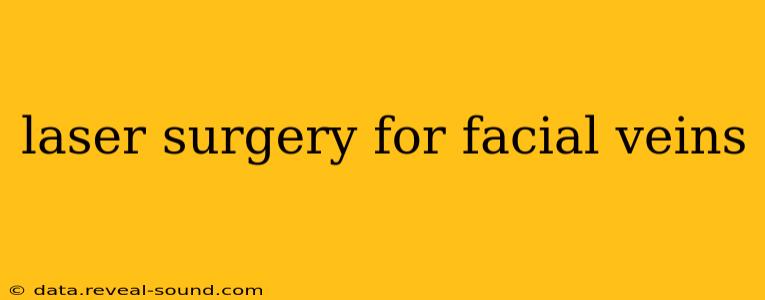Facial veins, those tiny, purplish or reddish lines that spiderweb across the face, can be a source of frustration for many. While often harmless, they can impact self-confidence and overall appearance. Thankfully, laser surgery offers a safe and effective solution for eliminating these unsightly veins. This comprehensive guide will delve into the intricacies of this procedure, answering common questions and addressing concerns.
What is Laser Surgery for Facial Veins?
Laser surgery for facial veins, also known as laser vein therapy or laser treatment for telangiectasia (the medical term for small, dilated blood vessels), utilizes intense pulsed light (IPL) or laser energy to target and eliminate these unwanted vessels. The laser's heat causes the vein walls to collapse, effectively closing off the vessel and preventing further blood flow. Over time, the body naturally absorbs the treated vein, leaving behind clear skin.
How Does Laser Treatment Work?
The procedure involves directing a precisely controlled beam of light onto the affected veins. The light energy is absorbed by the hemoglobin (the oxygen-carrying protein in red blood cells) within the veins. This absorption generates heat, causing the vein walls to seal shut. The procedure is typically quick and minimally invasive, requiring no incisions or stitches.
What are the Different Types of Lasers Used?
Several types of lasers are used for facial vein treatment, each with its own advantages and disadvantages. The choice of laser depends on several factors, including the size, depth, and color of the veins, as well as the patient's skin type. Common types include:
- Nd:YAG laser: This laser is effective for treating larger, deeper veins.
- Pulsed dye laser (PDL): This laser is particularly effective for treating superficial, smaller veins, and is often preferred for delicate facial areas.
- Intense Pulsed Light (IPL): IPL isn't technically a laser, but it uses broad-spectrum light to target veins and is often used for treating a combination of skin concerns, including redness and pigmentation.
What are the Benefits of Laser Vein Treatment?
Laser vein treatment offers several significant advantages over other methods:
- Minimal downtime: Most patients experience minimal downtime, with only mild redness and swelling immediately after the procedure. Makeup can often be applied the following day.
- Precise targeting: Lasers precisely target the affected veins, minimizing damage to surrounding skin.
- Effective results: The treatment is highly effective in removing or significantly reducing the appearance of facial veins.
- Quick procedure: The procedure typically takes only a short time, depending on the extent of the treatment area.
What is the Recovery Process Like?
Recovery is generally straightforward. You may experience some mild redness, swelling, or bruising immediately after the treatment, but this typically subsides within a few days. Avoid sun exposure and use sunscreen with a high SPF to protect the treated area. Your dermatologist will provide specific aftercare instructions.
How Many Treatments are Typically Needed?
The number of treatments required varies depending on the severity of the condition and individual response. Most patients require multiple sessions, spaced several weeks apart, to achieve optimal results. Your dermatologist will develop a personalized treatment plan based on your specific needs.
What are the Potential Side Effects?
While generally safe, potential side effects can include mild redness, swelling, bruising, and temporary changes in skin pigmentation. These side effects are usually temporary and resolve within a few days or weeks. Rarely, more serious complications may occur, such as scarring or infection. It's crucial to choose a qualified, experienced dermatologist to minimize risks.
Is Laser Vein Treatment Painful?
Most patients describe the treatment as causing a mild stinging or pinching sensation. A topical anesthetic cream may be applied to numb the area beforehand to further minimize any discomfort.
How Much Does Laser Vein Treatment Cost?
The cost of laser vein treatment varies based on the extent of the treatment area, the number of sessions required, and the type of laser used. It's best to consult with a dermatologist for a personalized quote.
How Long Do the Results Last?
The results of laser vein treatment are generally long-lasting, but new veins can develop over time. Maintaining a healthy lifestyle and avoiding excessive sun exposure can help to prolong the results. Follow-up treatments may be necessary in some cases.
This information is for educational purposes only and should not be considered medical advice. Always consult with a qualified dermatologist to determine if laser vein treatment is appropriate for you and to discuss any potential risks or side effects.
